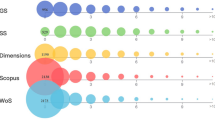Abstract
ResearchGate has launched its own citation index by extracting citations from documents uploaded to the site and reporting citation counts on article profile pages. Since authors may upload preprints to ResearchGate, it may use these to provide early impact evidence for new papers. This article assesses the whether the number of citations found for recent articles is comparable to other citation indexes using 2675 recently-published library and information science articles. The results show that in March 2017, ResearchGate found less citations than did Google Scholar but more than both Web of Science and Scopus. This held true for the dataset overall and for the six largest journals in it. ResearchGate correlated most strongly with Google Scholar citations, suggesting that ResearchGate is not predominantly tapping a fundamentally different source of data than Google Scholar. Nevertheless, preprint sharing in ResearchGate is substantial enough for authors to take seriously.

Similar content being viewed by others
References
Austin, P. C., & Hux, J. E. (2002). A brief note on overlapping confidence intervals. Journal of Vascular Surgery, 36(1), 194–195.
Brandão, M. A., & Moro, M. M. (2017). Social professional networks: A survey and taxonomy. Computer Communications, 100(1), 20–31.
de Solla Price, D. (1976). A general theory of bibliometric and other cumulative advantage processes. Journal of the American society for Information science, 27(5), 292–306.
Delgado López-Cózar, E., Robinson-García, N., & Torres-Salinas, D. (2014). The Google Scholar experiment: How to index false papers and manipulate bibliometric indicators. Journal of the Association for Information Science and Technology, 65(3), 446–454.
Halevi, G., & Moed, H. F. (2014). Usage patterns of scientific journals and their relationship with citations. In Proceedings of the Science and Technology Indicators Conference 2014 (STI 2014), Leiden, Netherlands (pp. 241–251).
Harzing, A. W., & Van Der Wal, R. (2009). A Google Scholar h-index for journals: An alternative metric to measure journal impact in economics and business. Journal of the American Society for Information Science and Technology, 60(1), 41–46.
Jamali, H. R. (in press). Copyright compliance and infringement in ResearchGate full-text journal articles. Scientometrics. doi:10.1007/s11192-017-2291-4.
Jordan, K. (2017). Understanding the structure and role of academics’ ego-networks on social networking sites. Ph.D. thesis, The Open University. http://oro.open.ac.uk/48259/.
Julious, S. A. (2004). Using confidence intervals around individual means to assess statistical significance between two means. Pharmaceutical Statistics, 3(3), 217–222.
Laakso, M., Lindman, J., Shen, C., Nyman, L., & Björk, B.-C. (2017). Research output availability on academic social networks: Implications for stakeholders in academic publishing. Electronic Markets. doi:10.1007/s12525-016-0242-1.
Meho, L. I., & Yang, K. (2007). Impact of data sources on citation counts and rankings of LIS faculty: Web of Science versus Scopus and Google Scholar. Journal of the American Society for Information Science and Technology, 58(13), 2105–2125.
Memon, A. R. (2016). ResearchGate is no longer reliable: Leniency towards ghost journals may decrease its impact on the scientific community. Journal of the Pakistan Medical Association, 66(12), 1643–1647.
Moed, H. F. (2005). Statistical relationships between downloads and citations at the level of individual documents within a single journal. Journal of the Association for Information Science and Technology, 56(10), 1088–1097.
Moed, H. F., Bar-Ilan, J., & Halevi, G. (2016). A new methodology for comparing Google Scholar and Scopus. Journal of Informetrics, 10(2), 533–551.
Mongeon, P., & Paul-Hus, A. (2016). The journal coverage of Web of Science and Scopus: A comparative analysis. Scientometrics, 106(1), 213–228.
Niyazov, Y., Vogel, C., Price, R., Lund, B., Judd, D., Akil, A., et al. (2016). Open access meets discoverability: Citations to articles posted to Academia.edu. PLoS ONE, 11(2), e0148257.
Orduña-Malea, E., Martín-Martín, A., & López-Cózar, E. D. (2016). ResearchGate como fuente de evaluación científica: Desvelando sus aplicaciones bibliométricas. El Profesional de la Información (EPI), 25(2), 303–310.
Priem, J., Taraborelli, D., Groth, P., & Neylon, C. (2010). Altmetrics: A manifesto. http://altmetrics.org/manifesto/.
ResearchGate. (2009). Self-archiving repository goes online. https://www.researchgate.net/blog/post/self-archiving-repository-goes-online.
ResearchGate. (2013). Introducing citations on ResearchGate. ResearchGate blog (7 February 2013). https://www.researchgate.net/blog/post/introducing-citations-on-researchgate.
ResearchGate. (2016). Introducing the h-index on ResearchGate. ResearchGate blog (8 March 2016). https://www.researchgate.net/blog/post/introducing-the-h-index-on-researchgate.
Thelwall, M. (2016a). Are the discretised lognormal and hooked power law distributions plausible for citation data? Journal of Informetrics, 10(2), 454–470.
Thelwall, M. (2016b). Citation count distributions for large monodisciplinary journals. Journal of Informetrics, 10(3), 863–874. doi:10.1016/j.joi.2016.07.006.
Thelwall, M. (2016c). The discretised lognormal and hooked power law distributions for complete citation data: Best options for modelling and regression. Journal of Informetrics, 10(2), 336–346.
Thelwall, M. (2017). Three practical field normalised alternative indicator formulae for research evaluation. Journal of Informetrics, 11(1), 128–151. doi:10.1016/j.joi.2016.12.002.
Thelwall, M., & Fairclough, R. (2015). Geometric journal impact factors correcting for individual highly cited articles. Journal of Informetrics, 9(2), 263–272.
Thelwall, M., & Fairclough, R. (in press). The accuracy of confidence intervals for field normalised indicators. Journal of Informetrics. doi:10.1016/j.joi.2017.03.004.
Thelwall, M., & Kousha, K. (2014). Academia.edu: Social network or academic network? Journal of the Association for Information Science and Technology, 65(4), 721–731.
Thelwall, M., & Kousha, K. (2015). ResearchGate: Disseminating, communicating and measuring scholarship? Journal of the Association for Information Science and Technology, 66(5), 876–889. doi:10.1002/asi.23236.
Thelwall, M., & Kousha, K. (2017). ResearchGate articles: Age, discipline, audience size and impact. Journal of the Association for Information Science and Technology, 68(2), 468–479.
Van Noorden, R. (2014). Scientists and the social network. Nature, 512(7513), 126.
Vaughan, L., & Shaw, D. (2003). Bibliographic and web citations: What is the difference? Journal of the American Society for Information Science and Technology, 54(14), 1313–1322.
Yu, M. C., Wu, Y. C., Alhalabi, W., Kao, H. Y., & Wu, W. H. (2016). ResearchGate: An effective altmetric indicator for active researchers? Computers in Human Behavior, 55, 1001–1006.
Zitt, M. (2012). The journal impact factor: Angel, devil, or scapegoat? A comment on JK Vanclay’s article 2011. Scientometrics, 92(2), 485–503.
Author information
Authors and Affiliations
Corresponding author
Rights and permissions
About this article
Cite this article
Thelwall, M., Kousha, K. ResearchGate versus Google Scholar: Which finds more early citations?. Scientometrics 112, 1125–1131 (2017). https://doi.org/10.1007/s11192-017-2400-4
Received:
Published:
Issue Date:
DOI: https://doi.org/10.1007/s11192-017-2400-4




